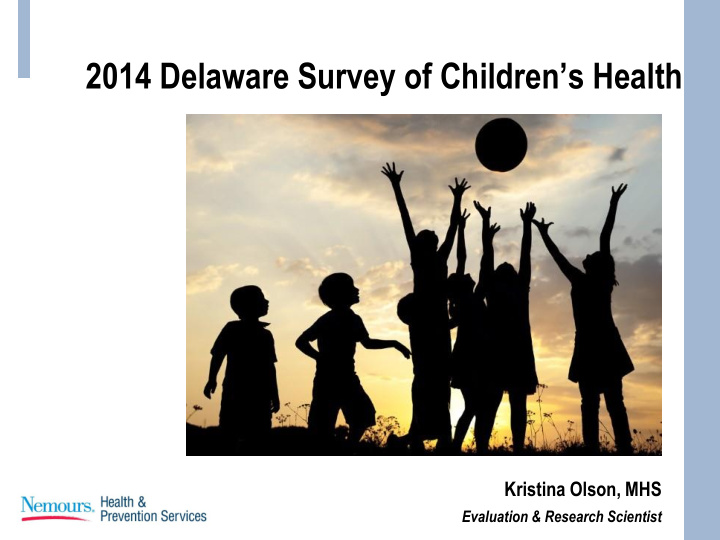



2014 Delaware Survey of Children’s Health Kristina Olson, MHS Evaluation & Research Scientist
Delaware Survey of Children’s Health (DSCH) 1) About the Delaware Survey of Children’s Health 2) Report back on findings from quality improvement activity
About the Delaware Survey of Children’s Health
About the DSCH Sponsored by Nemours Children’s Health System Comprehensive health surveillance instrument for Delaware children – Weight status, physical activity, healthy eating, health conditions, and children’s neighborhood and family environments, and more Goal: support data-driven decisions to improve the health of children in Delaware
Sampling Design Sample represents all Delaware households with one or more children age birth through 17 years – 2,657 households surveyed in 2014 Parent-reported data Designed for analysis and comparison of children by: Geographic Location Age Group Race and Ethnicity • City of Wilmington • Birth through 5 • Hispanic • New Castle County (NCC) • 6 through 11 • Non-Hispanic Black • NCC, excluding Wilmington • 12 through 17 • Non-Hispanic White • Kent County • Other • Sussex County
Dissemination Quality Improvement (QI) Activity
Dissemination Quality Improvement (QI) Activity QI survey administered June 24, 2016 at SEOW meeting 11 attendees completed and returned the survey The survey consisted of primarily open-ended questions. Survey feedback was reviewed by a team of NHPS investigators to identify themes across survey responses including: – best practices, – lessons learned, and – recommendations for future dissemination.
Dissemination QI Activity: CHANNELS • Respondents reported a variety of disseminations channels to be effective : in-person presentations, electronic channels, and print materials. • Social media received mixed support as a potentially effective strategy. Channels Why Effective In-Person Presentations Allow for interaction (e.g, questions & follow-up) Allow for education on what the findings mean Able to target specific groups (e.g., legislators, agency directors, professional organizations, direct service delivery groups, grant writing associated organizations) Electronic communications Use of technology allows for quick and broad dissemination (including social media) Electronic communication is the norm Print material Capture the audience’s attention with interesting and relatable data (specifically infographics)
Dissemination QI Activity: PRODUCTS • Variety of disseminations products reported to be effective: fact sheets or datagrams that referenced where to get more in-depth information (e.g., web site, detailed report), brochures, short reports, data briefs, PowerPoint slides, infographics, and commercials. Products Why Effective Fact sheets/datagrams Portable Immediately available Can be printed or electronically disseminated Short reports (topic Specific topics seemed to drum up interest more than a long specific) report, which can be overwhelming Data briefs Provide relevant information for program development and grant writing Infographics They capture the audience’s attention with interesting and relatable data
Dissemination QI Activity: PARTNERS • Variety of disseminations partners reported to be effective: individuals (including legislators and agency directors), organizations, coalitions (e.g., prevention, treatment, health care, law enforcement agencies), and informal networks. • Specific partners: physician offices, school nurses, Latin American Community Center, La Red Health Center, Health Ministries, Delaware Prevention Coalition, United Way of Delaware, Association of Fundraising Professionals – Brandywine Chapter, and Delaware Association for Nonprofit Advancement. Partners Why Effective Individuals Advocate can connect you to audience you desire to reach Get information to those with connections & impact Organizations Data can be tailored to specific organization Informal networks Delaware community is small enough that we are able to keep track of people even when they change jobs Data can be tailored to specific organization, network Coalitions Broad reaching Get information to those with connections & impact
Dissemination QI Activity: LESSONS LEARNED “I wouldn’t do this again…” Rely on any one single strategy – For example: posting information on a web site but not promoting the web site through any other strategies Rely on audience to seek out material online Disseminate literature at health fairs Host meetings with little incentive for attendees “But I would try this in the future …” Gather more input regarding what information would be beneficial to the target audience Utilize multiple strategies such as social media, print materials, peer groups, and partnership with other similar service agencies for dissemination
Dissemination QI Activity: “Here’s what you (DSCH) should do…” Share the data with a large network of individuals and organizations using multiple channels and products Target large groups and organizations that use data from similar surveys (e.g., YRBS) Include both electronic methods (e.g., email) and in-person strategies Sharing data in slide format Connect DSCH data to other survey data
Dissemination QI Activity: General Conclusions and Recommendations Channels Use multiple dissemination channels, including in-person presentations, electronic channels, and print materials. Be proactive in getting the data to the target audience. Do not rely on the target audience to actively seek out the data. Products Use a mix of dissemination products, including shorter materials (e.g., fact sheets and infographics) that referenced where to get more in-depth information, data briefs, and PowerPoint slides. Partners Leverage existing relationships with individuals who can advocate within their organizations or can use the data for great impact (e.g., legislators, agency directors). Distribute information through organizations, coalitions, and informal networks whose work can be influenced by the data.
NHPS Datacenter: datacenter.nemours.org Explore health topics Read data briefs synthesizing DSCH findings on a variety of topics View data by location, age, gender, and race/ethnicity
Q & A
Kristina Olson, MHS Evaluation and Research Scientist Nemours Children's Health System Division of Health & Prevention Services kristina.olson@nemours.org
Recommend
More recommend